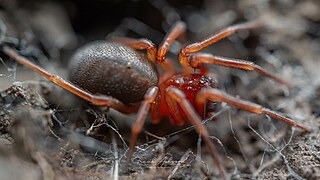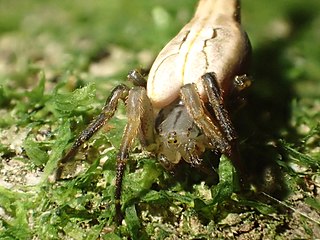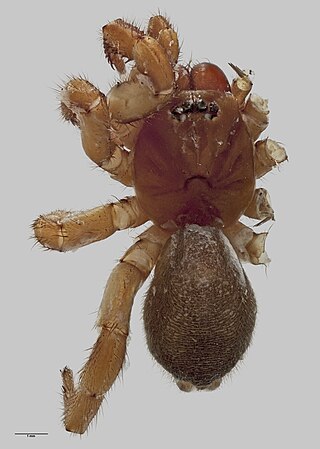
Trite planiceps, commonly known as the black-headed jumping spider, is a common jumping spider (Salticidae) endemic to New Zealand and one of about 150 species of jumping spiders in New Zealand.

Dolomedes schauinslandi or the Rangatira spider is a large spider of the family Pisauridae. It is only found on South East Island (Rangatira), Houruakopara and Mangere Islands in the Chatham Islands, New Zealand. It is one of New Zealand's largest and rarest spiders.

Periegops suterii is a species of spider in the genus Periegops that is endemic to the South Island of New Zealand.

Anoteropsis hilaris, commonly referred as the garden wolf spider or the grey wolf spider, is a species of wolf spider that is endemic to New Zealand.

Arachnura feredayi, the tailed forest spider, is endemic to New Zealand. it is known for the distinctive tapering body shape in females which are also much larger than males, and for producing vertical columns of eggsacs in the 12 o'clock position in their webs.
Cantuaria gilliesi is a species of trapdoor spider endemic to New Zealand.
Cantuaria insulana is a species of trapdoor spider endemic to New Zealand.
Cantuaria isolata is a species of trapdoor spider endemic to New Zealand.
Cantuaria stephenensis is a species of trapdoor spider endemic to New Zealand.
Cantuaria stewarti is a species of trapdoor spider endemic to New Zealand.

Stanwellia hapua is a species of Mygalomorph spider endemic to New Zealand.
Stanwellia puna is a species of Mygalomorph spider endemic to New Zealand.

Stanwellia regia is a species of Mygalomorph spider endemic to New Zealand.

Stanwellia taranga is a species of Mygalomorph spider endemic to New Zealand.

Migas borealis is a species of Mygalomorph spider endemic to New Zealand.
Migas giveni is a species of Mygalomorph spider endemic to New Zealand.

Migas insularis is a species of Mygalomorph spider endemic to New Zealand.
Migas sandageri is a species of Mygalomorph spider endemic to New Zealand.
Ascuta insula is a species of Orsolobidae spider of the genus Ascuta. The species is endemic to New Zealand.
Duripelta australis is a species of Orsolobidae. The species is endemic to New Zealand.










